コラム
落合憲弘
John Sypal
タカザワケンジ
なぎら健壱

Alright, by now you have probably noticed a general theme in the kind of books I like to share here. If there’s a book of black and white pictures taken in eastern Tokyo decades ago, yeah, I’m going to want to take a look at it.
A good example is Shigeru Yamazaki’s book “The Station 1974-1977”, which I shared here a year ago. (https://photoandculture-tokyo.com/contents.php?i=1453)
On a recent visit to Sokyusha, a book of his I hadn’t seen yet caught my eye- and my choice of it for this week’s column won’t come as a surprise.
Asakusa 1974.
Published by Place M in 2022, this is a collection of photos taken by Yamazaki in- you guessed it— Asakusa. In 1974.
Located in eastern Tokyo, the Asakusa district has drawn crowds for centuries. Its centerpiece, a large Buddhist temple called Senso-ji, is said to have been founded in the year 645. From the Edo period Asakusa became a grand entertainment district with theaters and geisha and other amusements. Later came the movies, ero-guro culture, and, after being destroyed once by a quake in 1923, the area was rebuilt with more theaters, bars, dancing girl halls, and cafes. After being leveled yet again in 1945, it was rebuilt along similar lines of amusement- yet postwar lost crowds to Ginza (Classier) and later, to the new gaudy districts of Shinjuku and Shibuya as the metropolis grew ever westward.
For Asakusa the 1970s seemed to be a bit of a lull. But while the rest of Tokyo, or at least its growing middle class, was enjoying its Economic Miracle and skyscrapers and suburbs, Asakusa kept plugging along. Writer Edward Seidensticker noted that here:
“There is still something down-to-earth and carpe-diem about it that is not to be found in the humming centers of the High City, or in the stylish, affluent suburbs.”
Yamazaki’s pictures suggest that he was drawn to the place by that “down to earth” feeling- something found in an irresistible combination of the people who would visit major religious site or a maze of grungy little backstreets and stalls.
Asakusa is alive in these pages.
Laborers manhandle the last of the old wooden-spoked push carts between young tourists and new Toyotas. Nearby families enjoy a Sunday afternoon with soda and balloons. Yamazaki found both stylish post-war born couples dressed in wide lapels and bellbottoms and withered, kimonoed elderly whom no doubt had recollections of Asakusa’s Taisho heydays. While the temple grounds are smoothly paved today, the Asakusa-spectacle which Yamazaki captured played out a stage of hard-packed dirt and busted-up concrete- or, on rainy days, plains of vast, muddy puddles.
Asakusa 1974 has a leisurely pace to it. As with his book “The Station” Yamazaki’s pictures (shot around the same time) have a natural, unaffected feel to them. He didn’t scramble for angles- it was enough to look ahead, straight on at the life around him. While each picture has an identifiable shutter-motive, the photos as a whole are often not about any one thing or person in particular. In them- and across the pages- are moments of simple action and glances.
One such glance is on the book’s cover. A young woman in a traditional hairstyle and kimono looks into the camera. Behind her a sign advertises “Commemorative Pictures”. Its use of anachronistic kanji could have been done for effect- or out of stubbornness. (Either way is very Asakusa.)
“Commemorative photos”.
Photography like Yamazaki’s here is just that- commemorations of the everyday that, when grouped around a particular place (Asauksa) and time (1974), charmingly illustrate the past.
As you can see, for this column I went to Asakusa to photograph the book pages in the same spots Yamazaki did. While much of the book is recognizable in spirit and street-corners, the details are missing. There’s no more grime, no more dirt. Or bellbottoms. 1974 is long gone.
Still, the temple complex continues to draw crowds, albeit now mainly of international tourists. This influx combined with the Instagramiffication of contemporary culture has had an effect on the face of Asakusa. Old stores and sagging buildings have been replaced with sleekly-styled cafes and bright souvenir shops. Rental kimonos are a must for west-Tokyo’s (or mainland China’s) urban young women who spend the afternoon here. On a noisy Sunday afternoon Sensoji merely a prop or backdrop for a social media post. Japan-land!
As much as I’d love a time machine and an afternoon or two to enjoy these mid-Seventies streets, maybe the fact that throngs of people still fill its streets shows it’s not so different after all. While the subject matter might have changed, the place remains fertile turf for photographers today.
There is a lot to see- Asakusa lives on.
Asakusa 1974 is available for purchase at Sokyusha or Place M in Shinjuku.
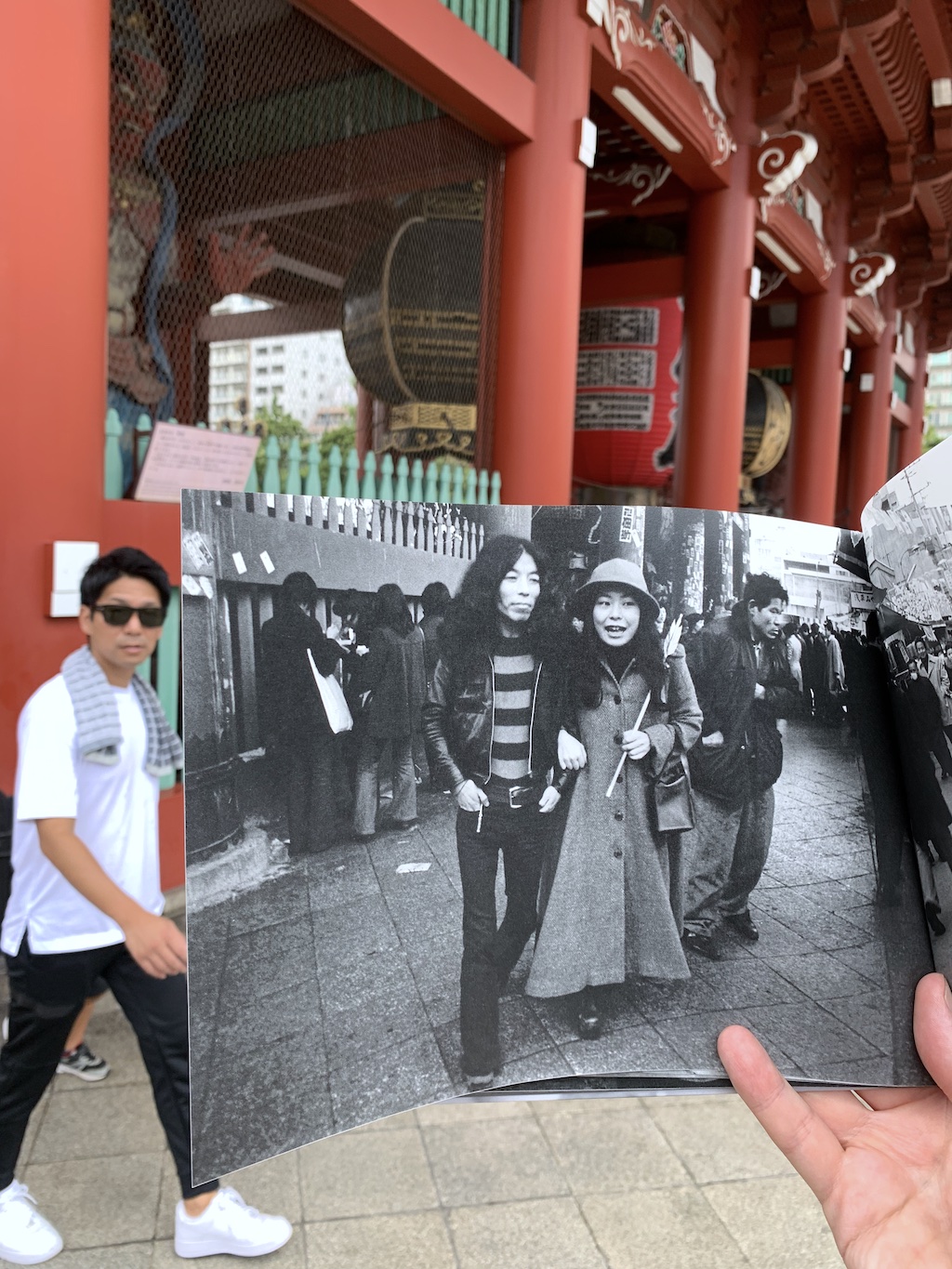
このコラムの読者の皆様はもうお気づきでしょうが、私がここで紹介している写真集にはテーマがあります。やっぱり何十年も前に東京の東部で撮影されたモノクロ写真集を見てみたくなるんです。
1年前に紹介した山崎茂さんの『The Station 1974-77』がいい例かもしれません。
そして最近、新宿にある蒼穹舎を訪れるとまだ見たことのない山崎さんの写真集が目に留まり、今週のコラムに選びました。
タイトルは『浅草1974』。2022年にPlace Mから出版されたこの写真集は、タイトルのとおり山崎さんが1974年に浅草で撮影した作品で構成されています。

浅草にとって、1970年代はちょっとした小休止だったようです。東京の他の地域、少なくとも中流階級が経済の奇跡を享受し、超高層ビルや郊外住宅を建設している間、浅草は前進を続けていました。日本文学作品の翻訳者、エドワード・G・サイデンステッカーはこう述べています。
- 「浅草には、高層ビルが立ち並ぶ都心部や、スタイリッシュで豊かな郊外にはない、地に足の着いたカルペ・ディエムのようなものが残っている」
- エドワード・G・サイデンステッカー
山崎さんの写真によれば、彼はその「地に足の着いた」感覚、つまり主要な宗教施設を訪れる人々や、小汚い路地裏、露店の迷路のような魅力的な組み合わせに惹かれたようなのです。
この写真集の中で、浅草は生きているのです。
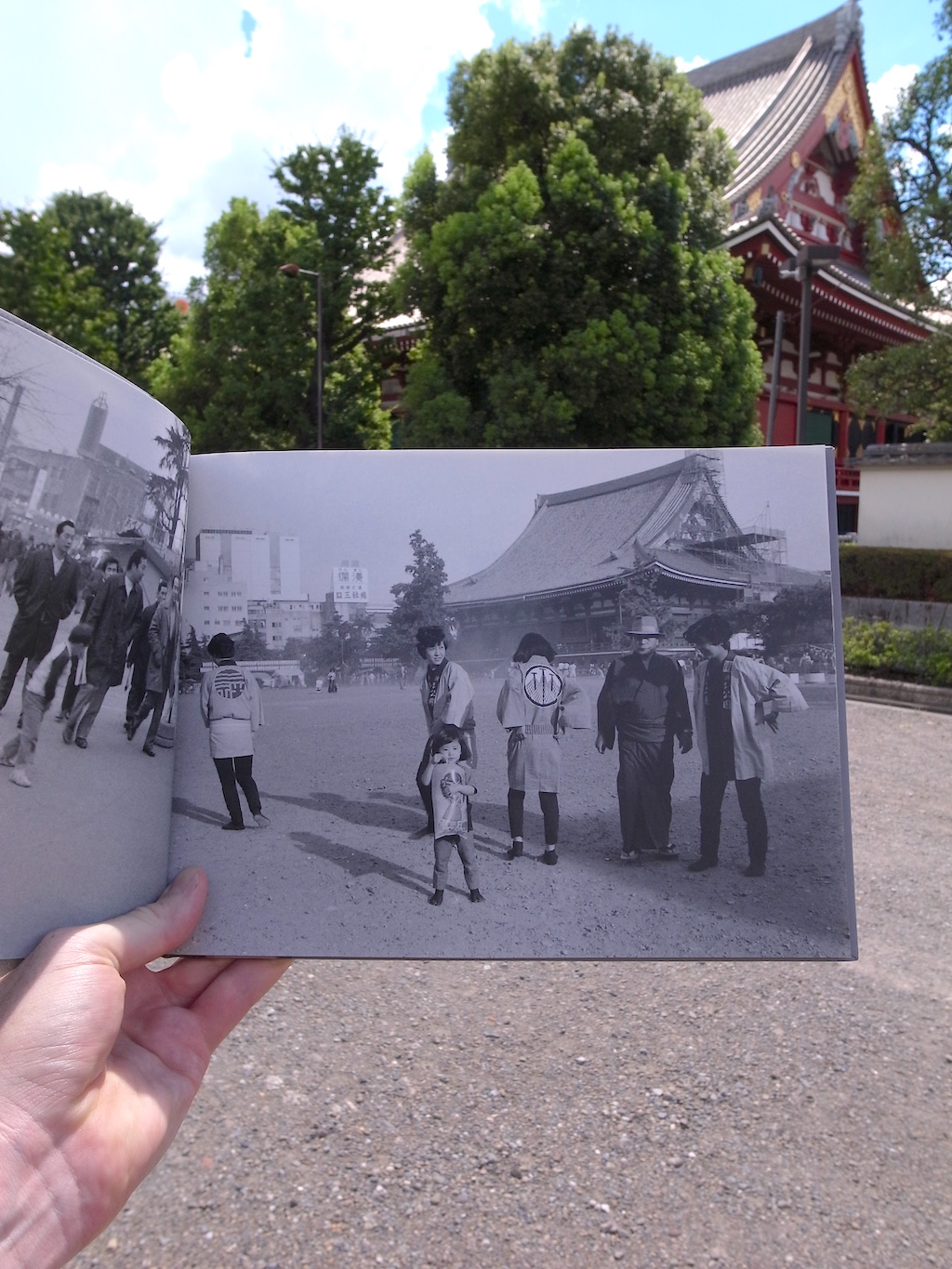
労働者たちは、若い観光客とトヨタの新車の間で古い木桶の押し車を操っており、近くの家族連れはソーダと風船で日曜の午後を楽んでいます。山崎さんは、戦後生まれのスタイリッシュなカップルも、大正時代の浅草を思い起こさせるような着物姿の老人も撮っています。現在、浅草寺の境内は美しく補修されていますが、山崎さんが撮影した浅草の光景は、固い土とボロボロのコンクリート、あるいは雨の日には広大な泥水が広がっているのです。
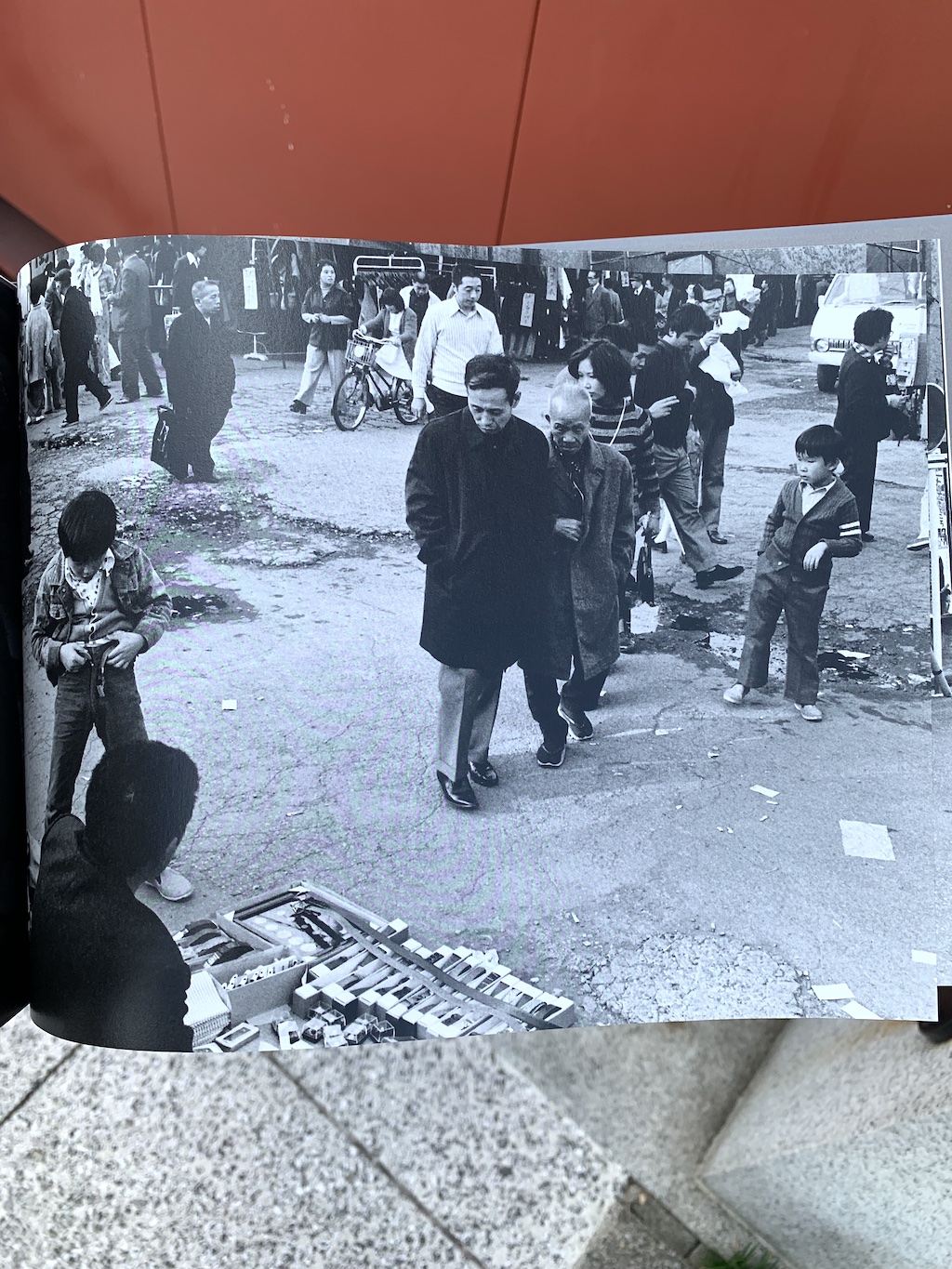
『浅草1974』で流れている時間はゆったりとしています。彼はダイナミックなアングルに奔走することなく、前を見て、周囲の生活をまっすぐに見つめるだけで十分だったのです。それぞれの写真にシャッターを切る動機が写されていますが、写真全体としては特定の物や人物についてではないことが多いように見えます。その中に、そしてページ全体に、シンプルな行動と視線の瞬間があるのです。
もっとも特徴的な視線の写真が表紙に施されています。伝統的な髪型の着物姿の若い女性がカメラを見つめている一枚です。彼女の背後にある「記念寫眞」の看板は効果的で、実に浅草らしいです。
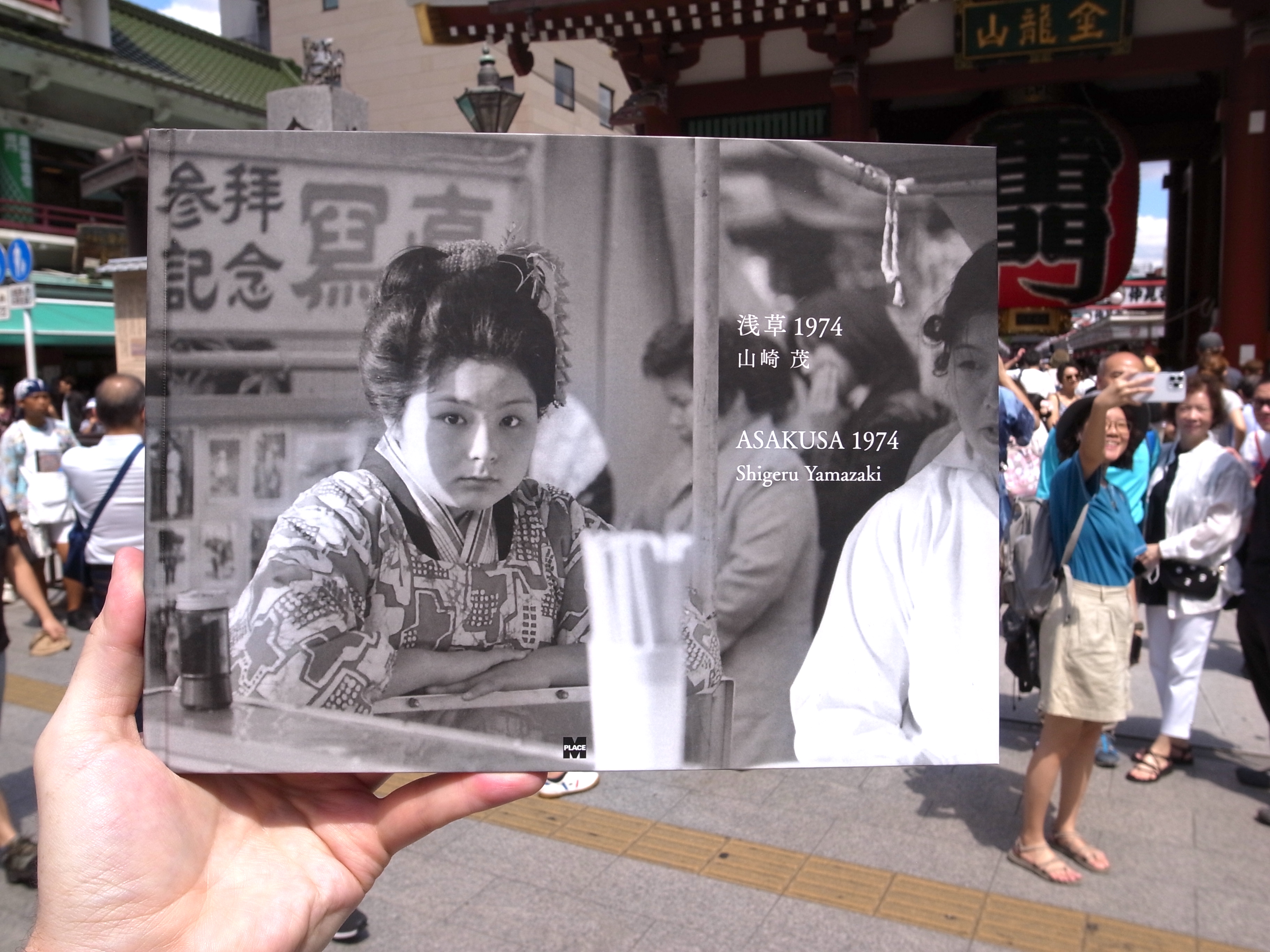
山崎さんの写真はまさに日常の「記念写真」であり、特定の場所(浅草)と時間(1974年)を中心にグループ化することで、過去を魅力的に表現しています。
このコラムのために私は浅草に行き、山崎さんが歩いたのと同じ道で本のページを撮影してみました。周りの人から何をしているのか?という目で見られました(笑)。写真集に写された場所の多くはフィーリングや実際に街を歩いてみて認識できるものの、細部は失われており、当時の垢や汚れはありません。1974年はとうに過ぎ去っているのです。
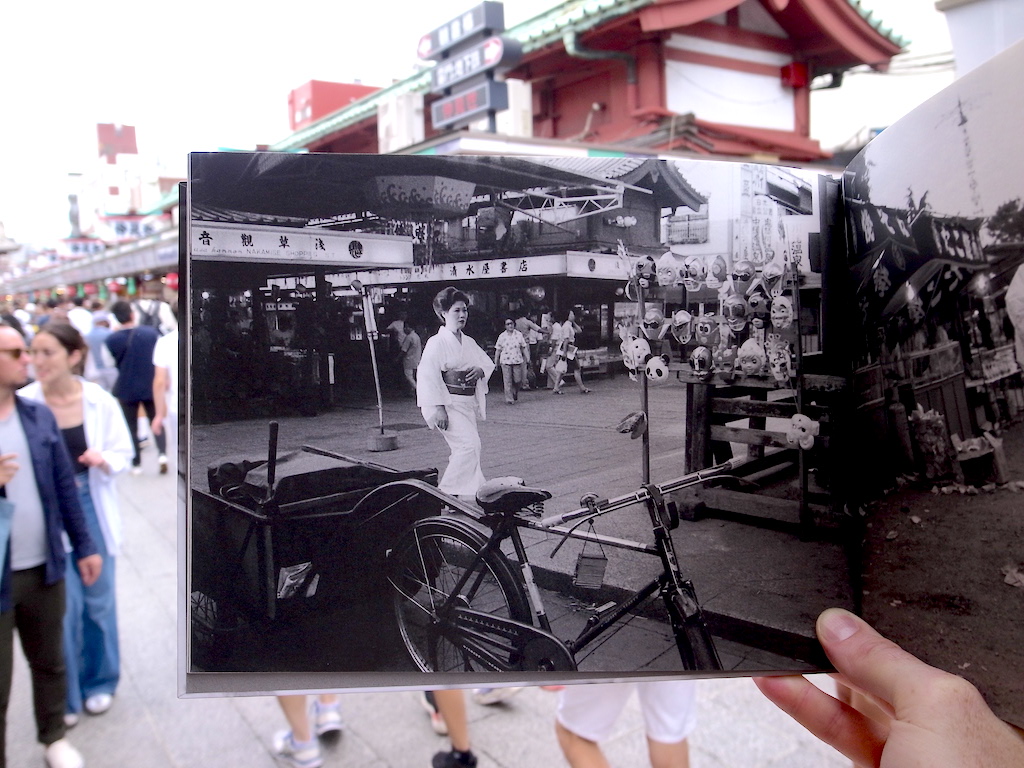
寺院などの複合施設には、今では主に外国人観光客が多く訪れ、人だかりをつくり続けています。現代のグローバル文化、Instagram効果と相まって、浅草の光景は年々変化を続けているのです。古い店舗や老朽化した建物は洗練されたスタイルのカフェや明るい土産物屋に取って代わられており、日曜午後の浅草はとても騒がしかったです。
浅草が大好きな私、タイムマシンに乗って1970年代半ばに行ってゆったりとした午後のひと時を過ごしてみたいものですが…。今でも大勢の人々が通りを埋め尽くしているという事実は、結局のところ、それほど変わっていないのかもしれません。被写体は変わっても、写真家にとって浅草という場所は肥沃な土地であることに変わりはありませんね。浅草は生き続けています。

- Shigeru Yamazaki. “Asakusa 1974”
- Publisher: Place M, 2022
- 山崎茂写真集 『浅草1974』
- 発行:Place M
- 発行日:2022年1月15日
仕様:A4変型、上製、モノクロ、88ページ、作品点数72点
定価:4000円(税込)- http://blog.livedoor.jp/sokyusha/archives/52225365.html
 26 Duets? Duels? Near-overlaps of time and Space across Tokyo. 東京の時間と空間が重なり合う写真集ツアー
2025/04/04
26 Duets? Duels? Near-overlaps of time and Space across Tokyo. 東京の時間と空間が重なり合う写真集ツアー
2025/04/04
 25 Naoki Ishikawa "TOKYO The City Where I Was Born" 石川直樹『東京 ぼくの生まれた街』
2024/01/05
25 Naoki Ishikawa "TOKYO The City Where I Was Born" 石川直樹『東京 ぼくの生まれた街』
2024/01/05
 24 山内道雄 Michio Yamauchi『TOKYO UP CLOSE』
2023/10/20
24 山内道雄 Michio Yamauchi『TOKYO UP CLOSE』
2023/10/20


PCT Membersは、Photo & Culture, Tokyoのウェブ会員制度です。
ご登録いただくと、最新の記事更新情報・ニュースをメールマガジンでお届け、また会員限定の読者プレゼントなども実施します。
今後はさらにサービスの拡充をはかり、より魅力的でお得な内容をご提供していく予定です。
 「Photo & Culture, Tokyo」最新の更新情報や、ニュースなどをお届けメールマガジンのお届け
「Photo & Culture, Tokyo」最新の更新情報や、ニュースなどをお届けメールマガジンのお届け 書籍、写真グッズなど会員限定の読者プレゼントを実施会員限定プレゼント
書籍、写真グッズなど会員限定の読者プレゼントを実施会員限定プレゼント